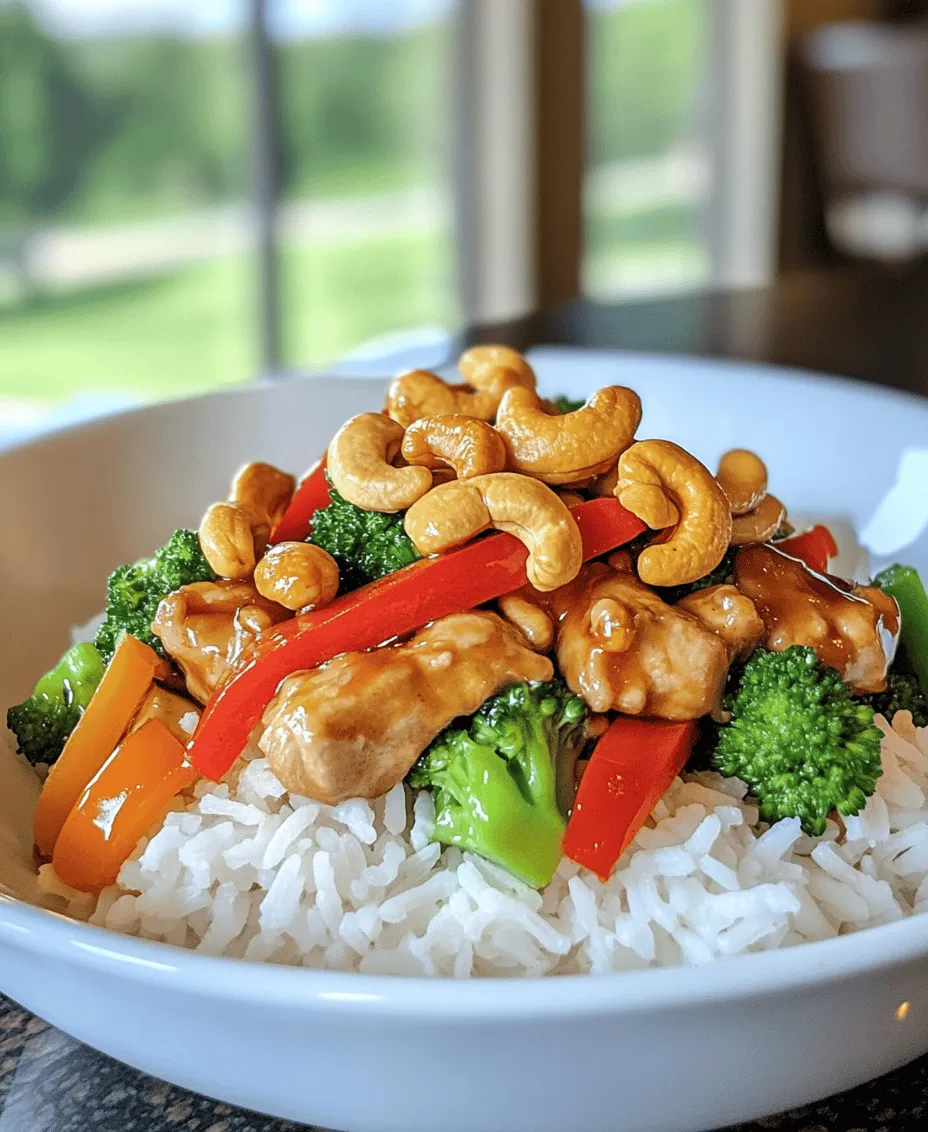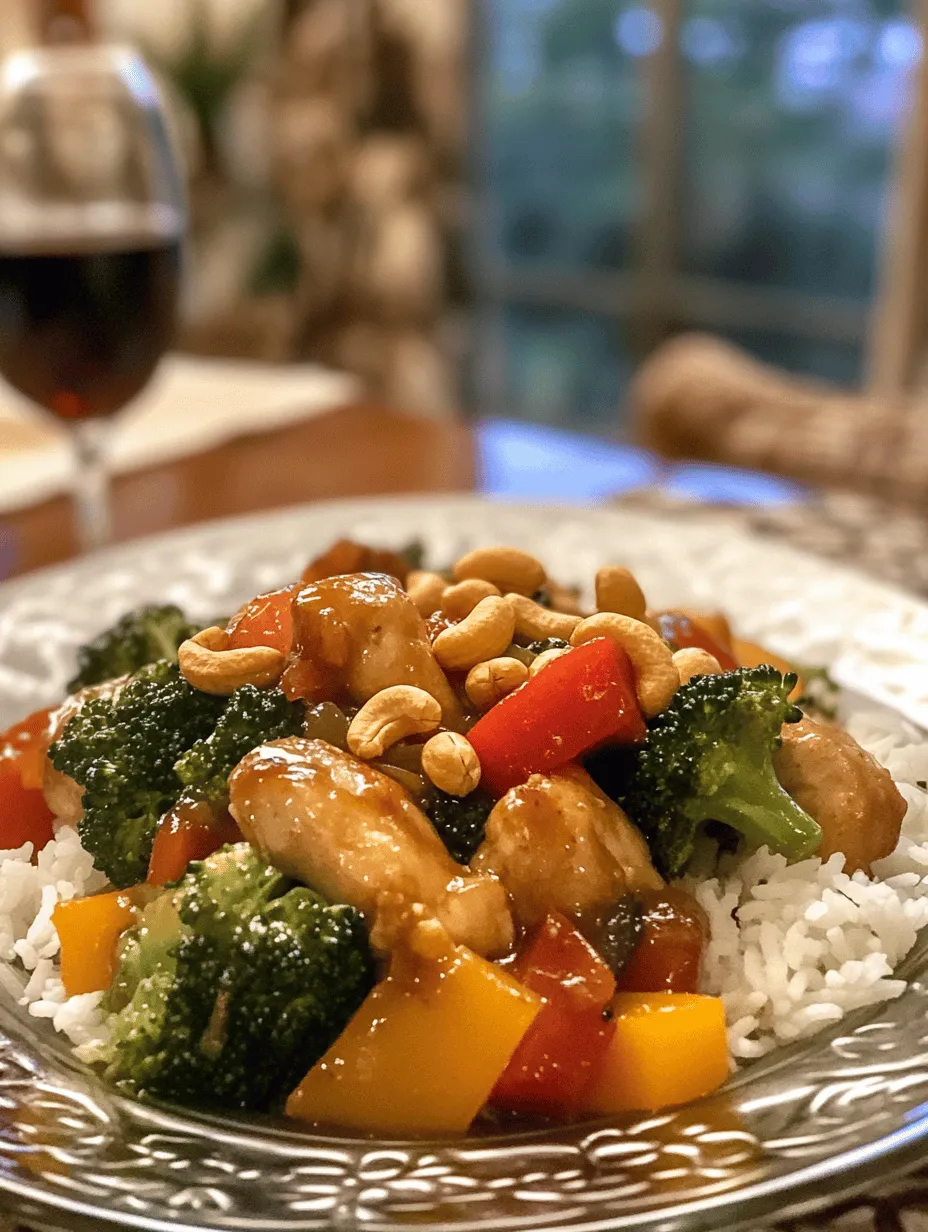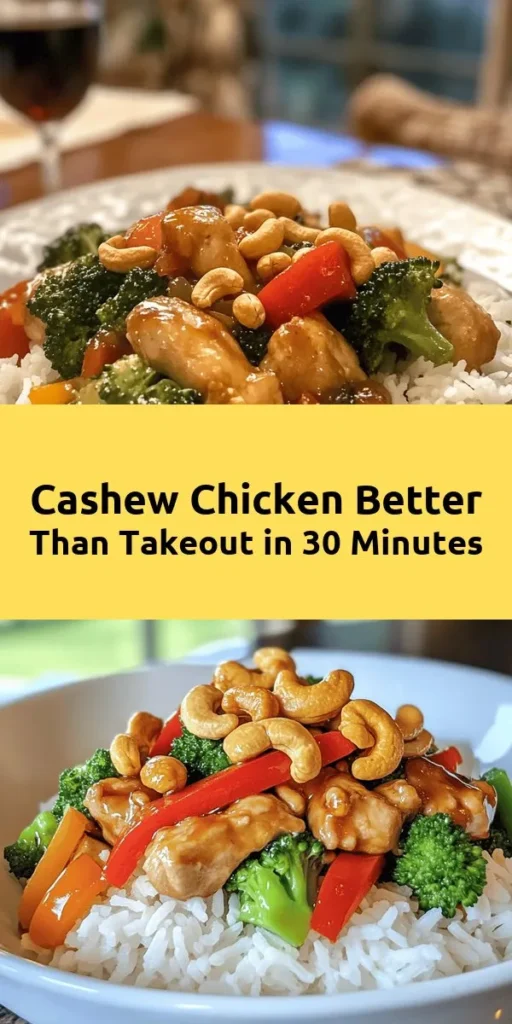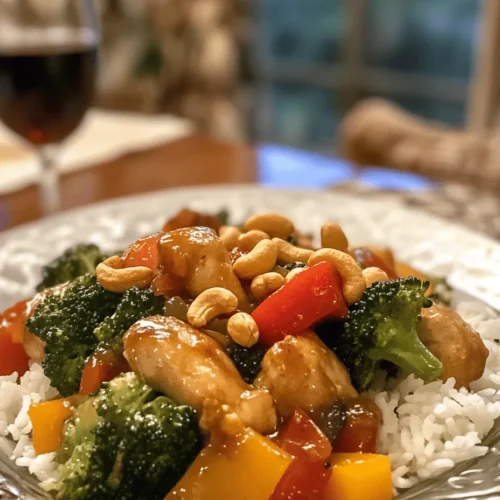Introduction
In the fast-paced world we live in, takeout Chinese food has become a popular go-to for busy families and individuals seeking a quick and satisfying meal. From the comforting warmth of fried rice to the savory goodness of sweet and sour chicken, these dishes have found a special place in our hearts. However, while takeout offers convenience, it often comes with hefty portions of sodium, preservatives, and added sugars. Enter the Better-Than-Takeout Cashew Chicken—a culinary masterpiece that not only rivals your favorite takeout but also elevates it by allowing you to customize flavors and ingredients according to your preferences.
This delectable dish combines tender pieces of chicken, crunchy cashews, and an array of vibrant vegetables, all tossed in a rich and savory sauce that’s bursting with flavor. Making Cashew Chicken at home means you can control the ingredients, ensuring a healthier meal that’s fresher and free from the excesses often found in restaurant dishes. Imagine the satisfaction of whipping up this classic dish in your own kitchen and enjoying it hot off the stove, paired with fluffy white or jasmine rice. The medley of textures and tastes will tantalize your taste buds, making it a new favorite for weeknight dinners or special occasions.
Understanding Cashew Chicken
Origins and History of Cashew Chicken in Chinese Cuisine
Cashew Chicken is a dish that reflects the beautiful fusion of flavors and culinary traditions, originating from Chinese cuisine. While the exact origins are somewhat murky, it is believed that the dish was first popularized in the United States by Chinese immigrants in the mid-20th century. The dish typically features diced chicken stir-fried with cashews, vegetables, and a savory sauce. Over the years, it has evolved into a staple of American Chinese cuisine, adored for its balance of flavors and textures.
In traditional Chinese cooking, cashews were not commonly used. Instead, the dish was often prepared with peanuts or other nuts. However, the introduction of cashews was a game-changer, adding a delightful creaminess and crunch that perfectly complements the tender chicken. Today, Cashew Chicken is widely enjoyed across the globe, often found on the menu of Chinese takeout restaurants and loved by many for its satisfying combination of protein, healthy fats, and colorful vegetables.
Why This Dish Has Become a Favorite in Western Takeout
The appeal of Cashew Chicken in Western takeout can be attributed to its well-rounded flavor profile and versatility. The dish is not only delicious but also visually appealing, with its vibrant colors from the vegetables and the golden-brown cashews. It strikes a perfect balance between savory and slightly sweet, making it a crowd-pleaser for both kids and adults alike.
Moreover, Cashew Chicken is adaptable, allowing for a variety of substitutions and additions based on dietary preferences or what’s available in your pantry. Whether you prefer extra vegetables, a spicy kick, or a gluten-free sauce, this dish can easily be tailored to suit your taste. These qualities, combined with its satisfying nature, have solidified Cashew Chicken’s status as a beloved favorite in the realm of takeout.
Comparison Between Traditional Recipes and This Healthier Version
While traditional Cashew Chicken recipes often rely on heavy sauces and deep-frying methods, our Better-Than-Takeout Cashew Chicken recipe takes a healthier approach. By using boneless, skinless chicken breasts and incorporating a variety of fresh vegetables, this version reduces unhealthy fats and calories without sacrificing flavor. The sauce is made with wholesome ingredients that can be adjusted according to your dietary needs, such as low-sodium soy sauce or gluten-free alternatives.
Additionally, this homemade recipe allows you to control the level of sweetness and saltiness, ensuring that you enjoy a dish that aligns with your health goals. The use of fresh produce not only enhances the nutritional profile but also adds vibrant colors and textures, making each bite a delightful experience. By preparing Cashew Chicken at home, you can create a dish that is just as satisfying as takeout, but with a focus on health and quality.
Ingredients Breakdown
Chicken: Importance of Using Boneless, Skinless Chicken Breast
At the heart of any good Cashew Chicken is the chicken itself. For this recipe, boneless, skinless chicken breast is the ideal choice. This lean cut of meat is not only lower in fat but also cooks quickly and evenly, ensuring tender and juicy results. When selecting your chicken, look for fresh, high-quality breast meat, preferably organic or free-range, to enhance the flavor and nutritional value of your dish.
Using chicken breast also allows for better absorption of the sauce and complements the crunchy cashews and vegetables beautifully. To prepare, simply cut the chicken into bite-sized pieces, making it easier to cook and serve.
Cashews: Nutritional Benefits and Role in the Dish
Cashews are the star ingredient in this recipe, providing both flavor and texture. These creamy nuts are rich in healthy fats, protein, and essential minerals like magnesium and zinc. They not only add a delightful crunch to the dish but also help to keep you feeling full and satisfied.
In terms of flavor, cashews have a naturally sweet and buttery taste that pairs excellently with the savory elements of the sauce. When cooked, they soften slightly while retaining their crunch, creating a wonderful contrast to the tender chicken and crisp vegetables. For a healthier option, consider using raw or lightly roasted cashews without added salt.
Fresh Vegetables: Benefits of Using Broccoli, Bell Peppers, and Snap Peas
A key component of the Better-Than-Takeout Cashew Chicken is the array of fresh vegetables, which not only adds color but also boosts the nutritional profile of the dish. In this recipe, we recommend using broccoli, bell peppers, and snap peas.
– Broccoli is packed with vitamins C and K, fiber, and antioxidants, making it a nutritious addition.
– Bell peppers come in a variety of colors, adding visual appeal and are rich in vitamins A and C, contributing to a healthy immune system.
– Snap peas are sweet and crunchy, providing a refreshing contrast to the other ingredients while offering fiber and vitamins.
By incorporating these vegetables, you enhance the dish’s flavor, texture, and health benefits, making it a well-rounded meal that satisfies both hunger and nutritional needs.
Aromatics: Role of Garlic and Ginger in Enhancing Flavor
No stir-fry is complete without aromatics, and in this Better-Than-Takeout Cashew Chicken recipe, garlic and ginger play a pivotal role. These ingredients not only provide depth of flavor but also contribute to the overall health benefits of the dish.
– Garlic is known for its immune-boosting properties and adds a pungent, savory kick that complements the other ingredients beautifully.
– Ginger introduces a warm and slightly spicy note, enhancing the dish’s complexity and elevating the overall flavor profile.
When preparing your cashew chicken, be sure to use fresh garlic and ginger for the best results. Finely mince or grate them to release their essential oils and maximize their flavor impact in the dish.
Sauces: Explanation of Soy Sauce, Oyster Sauce, and Their Alternatives
The sauce is where the magic happens in Cashew Chicken, and it’s essential to choose the right ingredients to achieve that perfect balance of flavors. The traditional sauce typically includes soy sauce and oyster sauce, both of which add umami and depth to the dish.
– Soy sauce is a staple in many Asian cuisines and provides a salty, savory element. For a healthier alternative, you can use low-sodium soy sauce or tamari for a gluten-free option.
– Oyster sauce is made from oyster extracts and adds a rich flavor that enhances the overall taste of the dish. If you’re looking for a vegetarian or vegan substitute, consider using mushroom sauce or a homemade blend of soy sauce and a touch of sugar.
Together, these sauces create a flavorful coating for the chicken and vegetables, ensuring that every bite is packed with umami goodness. Adjust the levels of the sauces according to your taste preferences, and don’t hesitate to experiment with additional ingredients like sesame oil or chili paste for added complexity.
Rice: Importance of Serving with White or Jasmine Rice
No Cashew Chicken is complete without a bed of rice to soak up the delicious sauce. Serving this dish with fluffy white or jasmine rice not only enhances the flavor experience but also provides a satisfying carbohydrate component to the meal.
Jasmine rice, with its fragrant aroma and slightly sticky texture, is particularly well-suited for Asian dishes, making it an excellent choice. Alternatively, you can opt for brown rice for a more nutritious option, providing additional fiber and nutrients. Whichever type of rice you choose, be sure to prepare it according to package instructions, fluffing it before serving to create the perfect base for your Cashew Chicken.
Preparation Steps
Preparing the Sauce: Importance of Cornstarch for Thickening
Before diving into the cooking process, it’s essential to prepare the sauce that will bring your Better-Than-Takeout Cashew Chicken to life. Start by combining your chosen soy sauce, oyster sauce, and any additional flavor-enhancing ingredients in a small bowl.
To achieve the perfect consistency, you’ll want to add cornstarch to the sauce mixture. Cornstarch acts as a thickening agent, ensuring that the sauce clings beautifully to the chicken and vegetables without being overly watery. Mix the cornstarch with a splash of cold water to create a slurry before incorporating it into the sauce. This step will help prevent lumps and ensure a smooth, glossy finish once cooked.
Cooking the Chicken: Techniques for Getting a Good Sear
With your sauce prepared, it’s time to cook the chicken. Start by heating a large skillet or wok over medium-high heat, adding a splash of oil to coat the surface evenly. For the best results, use an oil with a high smoke point, such as vegetable oil or peanut oil, to achieve a nice sear on the chicken.
Once the oil is hot, add the diced chicken breast in a single layer, ensuring not to overcrowd the pan. This will allow the chicken to sear properly and develop a beautiful golden crust. Cook for about 4-5 minutes on one side until browned, then flip the pieces to cook through. The goal is to achieve a crispy exterior while keeping the inside juicy and tender.
As the chicken cooks, resist the temptation to stir too frequently. Allowing it to sit undisturbed for a few minutes will create that coveted sear and enhance the flavor. Once the chicken is cooked through, remove it from the skillet and set it aside, keeping it warm while you prepare the vegetables and sauce.
—
As you continue with the preparation steps, the journey towards creating this Better-Than-Takeout Cashew Chicken becomes even more exciting. The combination of flavors, textures, and colors will transform your kitchen into a culinary haven, making it easy to see why this dish has become a favorite among home cooks and takeout lovers alike. Stay tuned for the subsequent steps in this delicious recipe!




